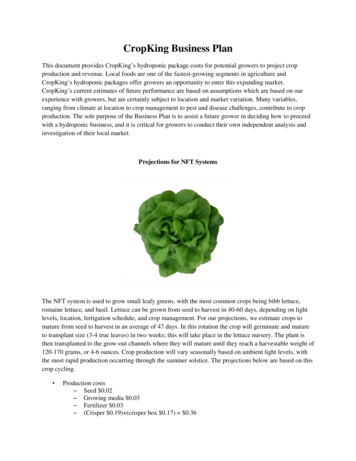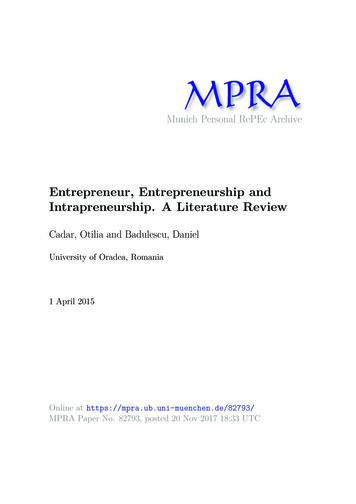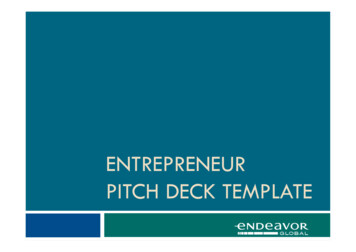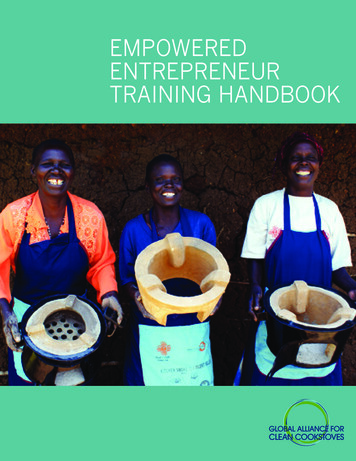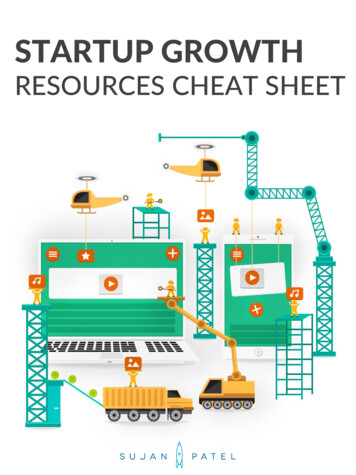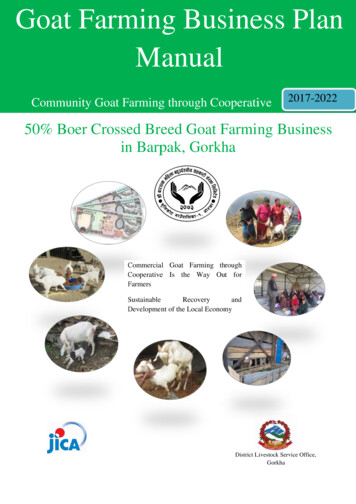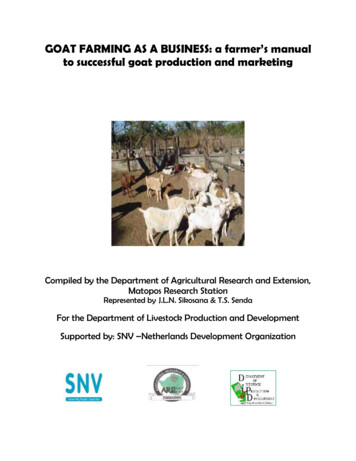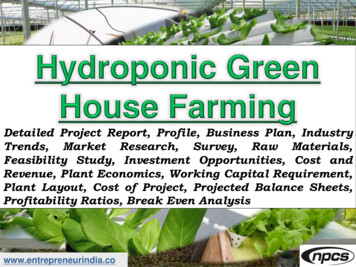
Transcription
www.entrepreneurindia.co
IntroductionHydroponics is a system of agriculture that utilizesnutrient-laden water rather than soil for plantnourishment. The re-use of nutrient water suppliesmakes process-induced eutrophication (excessive plantgrowth due to overabundant nutrients) and generalpollution of land and water unlikely, since runoff inweather-independent facilities is not a concern.www.entrepreneurindia.co
Aeroponic and hydroponic systems do not itional agricultural systems, and may be stacked(if outfitted with led lighting) in order to limit spaceuse (vertical farming). This makes them optimal foruse in cities, where space is particularly limited andpopulations are high-self-sustaining city-based foodsystems mean a reduced strain on distant farms, thereduction of habitat intrusions, fewer food miles, andfewer carbon emissions.www.entrepreneurindia.co
Boosted by rising consumer demand owing to betterhealth awareness and purchasing power, productionof fruits and vegetables across India has increasedthis year with their total yield surpassing theproduction of food grains. India is also a prominentexporter of Fresh Vegetables in the world.The country has exported 6,99,600.34 MT of FreshVegetables other than Onion to the world for theworth of Rs. 2119.50 crores during the year 201516.India grows the largest number of vegetables fromtemperate to humid tropics and from sea-level tosnowline. Thus, as an entrepreneur this projectoffers an exciting opportunity to you.www.entrepreneurindia.co
Market OutlookThe global hydroponics market is estimated to grow ata CAGR of 6.7% during the 2017-2022 forecastperiod. The hydroponics market value is anticipatedto grow from USD XX million in 2016 to USD 31436.7million by 2022. A sub-segment of hydro-culture,hydroponics is a method of growing plants usingmineral nutrient solutions, in water, without soil.Hydroponics method uses two main mediums to growcrops - solution culture and solid medium culture.www.entrepreneurindia.co
This method of farming is a niche segment gainingpopularity in urban, customized agriculture setup.Companies are mainly focusing on launching newproducts and facilities by investing in R&D activities.Partnerships and agreements with regional playersare being carried out to expand the global presenceby companies.www.entrepreneurindia.co
Global Hydroponics Market Revenue, by Crop Type in 2016www.entrepreneurindia.co
The global hydroponics market is projected to reachUSD 395.2 Million by 2020, growing at a CAGR of16.8% from 2015 to 2020.Global hydroponics crop value is anticipated to growfrom USD 18.8 billion in 2014 to USD 27.29 Billionby 2020 at an estimated CAGR of 6.39% from 2015 to2020.www.entrepreneurindia.co
Hydroponics Market Size, by Region (2015-2020)www.entrepreneurindia.co
Project at a GlanceCOST OF PROJECTMEANS OF ing Proposed TotalLand & Site DevelopmentExp.0.0035.0035.00 CapitalBuildings0.00408.00 408.00 Share PremiumOther Type SharePlant & Machineries0.0023.3023.30 CapitalMotor Vehicles0.008.008.00 Reserves & SurplusOffice AutomationEquipments0.006.556.55 Cash SubsidyTechnical KnowhowFees & Exp.0.002.002.00 Internal Cash AccrualsFranchise & OtherLong/Medium TermDeposits0.000.000.00 BorrowingsPreliminary& Preoperative Exp0.000.500.50 Debentures / BondsProvision forUnsecuredContingencies0.001.301.30 Loans/DepositsMargin Money - WorkingCapital0.004.154.15TOTAL0.00488.80 488.80 TOTAL0.000.00Total122.20 0.000.000.000.00366.60 366.600.000.000.000.000.000.000.00488.80 488.80www.entrepreneurindia.co
Project at a GlanceYearAnnualisedEPS CEPS Book Debt DividenValuedPer Share PerShare 1-2 -0.413.409.5924.000.002-30.263.679.8518.000.003-4 0.91451.55562.183.9710.77 dEarningsPer Share% 8Payout Probabl P/E Yield Price/eRatio Book ValueMarketPriceNo.ofTimes% dia.co
Project at a GlanceYearD. S. C. R.Debt / Equity Total ReturasNet n onDepos Equity Wort Netitsh WorthDebtIndivid Cumula Overualtiveall(Number of times)(Number oftimes)%Initial120.720.722.502.502.562-3 0.730.731.831.831.893-4 0.750.000.000.043.000.75%Profitability RatioGPMPBTPAT%%%Assets CurreTurnov nterRatioRatioNet P/VContri 3% -3.46%2.73% 2.21%11.86% 7.76%13.1720.66% %18.4629.17% 9 -15.82www.entrepreneurindia.co
Project at a GlanceBEPBEP - Maximum Utilisation YearCash BEP (% of Installed Capacity)Total BEP (% of Installed Capacity)IRR, PAYBACK and FACRInternal Rate of Return . ( In %age )Payback Period of the Project is ( In Years )Fixed Assets Coverage Ratio ( No. of times )548.53%69.95%-9.45%After 5 Years0.465www.entrepreneurindia.co
Major Queries/Questions Answered in the Report?1. What is Hydroponic Green House Farming ?2. How has the Hydroponic Green House performedso far and how will it perform in the coming years ?3. What is the Project Feasibility of HydroponicGreen House Farm ?4. What are the requirements of Working Capital forsetting up Hydroponic Green House Farm?www.entrepreneurindia.co
5. What is the structure of the Hydroponic GreenHouse Farming Businessand who are thekey/major players ?6. What is the total project cost for setting upHydroponic Green House Farm ?7. What are the operating costs for setting upHydroponic Green House Farm ?8. What are the machinery and equipmentrequirements for setting up Hydroponic GreenHouse Farm?www.entrepreneurindia.co
9. Who are the Suppliers and Manufacturers ofPlant & Machinery for setting up HydroponicGreen House Farming ?10. What are the requirements of raw material forsetting up Hydroponic Green House Farmingplant ?11. Who are the Suppliers and Manufacturers of Rawmaterials for setting up Hydroponic Green HouseFarming?www.entrepreneurindia.co
12. What is the total size of land required for setting upHydroponic Green House Farm?13. What will be the income and expenditures for aHydroponic Green House Farming?14.What are the Projected BalanceHydroponic Green House Farming?Sheetsof15. What are the requirement of utilities and overheadsfor setting up Hydroponic Green House Farm?16. What is the Built up Area Requirement and cost forsetting up Hydroponic Green House FarmingBusiness?www.entepreneurindia.co
17.WhatarethePersonnel(Manpower)Requirements for setting up HydroponicGreen House Farming Business?18.What is the time required to break-even ofHydroponic Green House Farming Business?19. What is the Break-Even Analysis of HydroponicGreen House Farming Business?20. What are the Project financials of HydroponicGreen House Farming Business ?www.entepreneurindia.co
21. What are the Profitability Ratios of HydroponicGreen House Farming Business?22. What is the Sensitivity Analysis-Price/Volume ofHydroponic Green House Farming Business?23.24.What are the Projected Pay-Back Period andIRR of Hydroponic Green House FarmingBusiness?What is the Process Flow Sheet Diagram of aHydroponic Green House Farming project?www.entrepreneurindia.co
25. What are the Market Opportunities for settingup HydroponicGreenHouseFarmingBusiness?26. What is the Market Study and Assessment forsetting up a Hydroponic Green House FarmingBusiness?27. What is the Plant Layout for setting up aHydroponic Green House Farming Business?www.entrepreneurindia.co
Table of Contentsof theProject Reportwww.entrepreneurindia.co
1.PROJECT LOCATION1.1.DISTRICT PROFILE & GEOTECHNICAL nistrative Set UpTransportationAvailability of ia.co
2. INTRODUCTION2.1.2.2.2.3.WORKING PRINCIPLEHYDROPONICS SYSTEMSCONSTRUCTION AND PROCESS3. BENEFITS4. ADVANTAGES OF HYDROPONICS4.1.4.2.4.3.INCREASED PRODUCTIVITYMORE ECO-FRIENDLYREDUCED TRANSPORTATIONwww.entrepreneurindia.co
5. HYDROPONIC CROPS6. B.I.S. SPECIFICATIONS6.1.6.2.6.3.IS 14461 (1997): SURFACE COVERED CULTIVATIONSTRUCTURESGLOSSARY OF TERMS [FAD 22: AGRICULTURALSYSTEMS ANDMANAGEMENT7. MARKET SURVEY7.1.7.2.7.3.VARIETIESAREAS OF CULTIVATIONINDIA FACTS AND FIGURESwww.entrepreneurindia.co
8. EXPORT & IMPORT STATISTICS DATA OFINDIA8.1.8.2.8.3.8.4.8.5.8.6.EXPORT STATISTICS DATA FOR TOMATOPRODUCTIMPORT STATISTICS DATA FOR TOMATOPRODUCTEXPORT STATISTICS DATA FOR PEAS PRODUCTIMPORT STATISTICS DATA FOR PEAS PRODUCTEXPORT STATISTICS DATA FOR CUCUMBERPRODUCTIMPORT STATISTICS DATA FOR CUCUMBERPRODUCTwww.entrepreneurindia.co
9. CLASSIFICATION OF GREENHOUSE9.1.9.2.9.3.CLASSIFICATION OF GREENHOUSE BASED ONSUITABILITYHYDROPONIC/GREENHOUSE CROPSPER ACRE SOIL YIELD VS. HYDROPONIC YIELDCOMPARISON10. FUTURE OF GROWING11. DESIGN AND ORIENTATION OFGREENHOUSE12. COMPONENTS OF GREENHOUSEwww.entrepreneurindia.co
13. ENVIRONMENTAL FACTORSINFLUENCING POLYHOUSE CULTIVATION14. MEDIA PREPARATION AND FUMIGATION14.1. TEMPERATURE NECESSARY TO KILL SOIL PESTS14.2. DRIP IRRIGATION AND FERTIGATION SYSTEMS15. PROCUREMENT OF PLANTING MATERIAL16. HYDROPONIC GREEN HOUSE FARMING16.1. CAPSICUMwww.entrepreneurindia.co
16.2.1.IntroductionClimateSoilPlanting DistancePlanting MaterialVarieties/CultivarsManures and FertilizersCultural PracticesIrrigationInsect and DiseasesHarvestingYieldPost Harvest ManagementTOMATO / CHERRY TOMATOIntroductionwww.entrepreneurindia.co
14.16.2.15.IntroductionStatus of Tomato in HaryanaClimateSoilPlanting DistancePlanting MaterialVarieties/CultivarsManures and FertilizersCultural PracticesIrrigationPlant preneurindia.co
CUCUMBERIntroductionClimateSoilPlanting DistancePlanting MaterialVarieties/CultivarsManures and FertilizersCultural PracticesIrrigationInsect and dia.co
16.4.14.ROSEIntroductionClimateSoilPlanting DistancePlanting MaterialTypes of Roses and VarietiesManures and FertilizersCultural PracticesIrrigationPest and eneurindia.co
16.5.14.CARNATIONIntroductionClimateSoilPlanting DistancePlanting MaterialVarietiesManures and FertilizersCultural PracticesIrrigationPest and eneurindia.co
17. SUPPLIERS OF PLANT & MACHINERY18. SUPPLIERS OF RAW MATERIAL19. PHOTOGRAPHS/IMAGES FOR REFERENCE19.1.19.2.19.3.19.4.19.5.MICRO IRRIGATIONPLANTING MATERIALCOMPOSTRAW MATERIAL PHOTOGRAPHSHYDROPONIC FARMING20. PLANT LAYOUTwww.entrepreneurindia.co
Project Financials Project at a GlanceAnnexure Assumptions for Profitability workings .1 Plant Economics .2 Production Schedule 3 Land & Building . 4Factory Land & BuildingSite Development Expenseswww.entrepreneurindia.co
Plant & Machinery . .5Indigenous MachineriesOther Machineries (Miscellaneous, Laboratory etc.) Other Fixed Assets . .6Furniture & FixturesPre-operative and Preliminary ExpensesTechnical KnowhowProvision of Contingencies Working Capital Requirement Per Month . 7Raw MaterialPacking MaterialLab & ETP Chemical CostConsumable Storewww.entrepreneurindia.co
Overheads Required Per Month and Per Annum . . 8Utilities & Overheads (Power, Water and Fuel Expenses etc.)Royalty and Other ChargesSelling and Distribution Expenses Salary and Wages . .9 Turnover Per Annum . 10 Share Capital .11Equity CapitalPreference Share Capitalwww.entrepreneurindia.co
Annexure 1 :: Cost of Project and Means of Finance Annexure 2 :: Profitability and Net Cash Accruals Revenue/Income/RealisationExpenses/Cost of Products/Services/ItemsGross ProfitFinancial ChargesTotal Cost of SalesNet Profit After TaxesNet Cash Accrualswww.entrepreneurindia.co
Annexure 3 :: Assessment of Working Capitalrequirements Current AssetsGross Working CapitalCurrent LiabilitiesNet Working CapitalWorking Note for Calculation of Work-inprocess Annexure 4 :: Sources and Disposition of Fundswww.entrepreneurindia.co
Annexure 5 ::Projected Balance Sheets ROI (Average of Fixed Assets) RONW (Average of Share Capital) ROI (Average of Total Assets) Annexure 6::Profitability Ratios D.S.C.R Earnings Per Share (EPS) Debt Equity Ratiowww.entrepreneurindia.co
Annexure 7::Break-Even Analysis Variable Cost & Expenses Semi-Variable/Semi-Fixed Expenses Profit Volume Ratio (PVR) Fixed Expenses / Cost B.E.Pwww.entrepreneurindia.co
Annexure 8 to 11 :: Sensitivity Analysis-Price/Volume Resultant N.P.B.T Resultant D.S.C.R Resultant PV Ratio Resultant DER Resultant ROI Resultant BEPwww.entrepreneurindia.co
Annexure 12 :: Shareholding Pattern and Stake Status Equity Capital Preference Share Capital Annexure 13 :: Quantitative Details-Output/Sales/Stocks Determined Capacity P.A of Products/Services Achievable Efficiency/Yield % of Products/Services/Items Net Usable Load/Capacity of Products/Services/Items Expected Sal
9. classification of greenhouse 9.1. classification of greenhouse based on suitability 9.2. hydroponic/greenhouse crops 9.3. per acre soil yield vs. hydroponic yield comparison 10. future of growing 11. design and orientation of greenhouse 12. components of greenhouse
